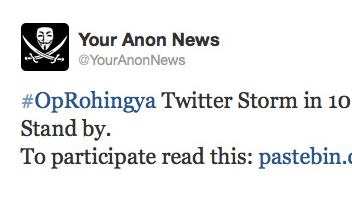For the last few days, the ‘hacktivist’ group Anonymous has used Twitter to bring the world’s attention to the persecution and genocide of the Rohingya people inside the Republic of the Union of Myanmar (Burma).
The Rohingya people are Muslim and are the minority in the state of Rakhine, the majority being Rakhine Buddhists. The Burmese government refuses to recognize the population of Rohingya people, which is estimated to be around 800,000. Hundreds of thousands of Rohingya have been forced into refugee camps in which the conditions can be described as terrifying and inhumane. Thousands have been slaughtered.
Since the Burmese government recognizes these people as illegal immigrants and not as citizens, they have been afforded no protection and subjected to what many have called genocide. When the Rohingya attempt to flee, they are often turned away or killed by neighboring countries. Without a doubt, they are a persecuted population in a situation which deserves a higher degree of attention from the international community and certainly from the press.
#OpRohingya, as Anonymous named it, was comprised of two parts. First, they inundated their many twitter accounts with #OpRohingya and #RohingyaNOW, which caused others outside of Anonymous to do the same.
It worked, and on Monday, #RohingyaNOW was the top hashtag trend on Twitter. It reached a peak of 24,000 Tweets per hour.
The second part of #OpRohingya involved Anonymous doing what they do best: hacking the websites of the parties they felt were guilty.
This internet mob organized yesterday was spearheaded by the hacktivist group Anonymous who began the day by shutting down 14 Myanmar government websites through Denial of Service attacks. Several other websites were defaced by typically nefarious-sounding hacker organizations such as Root Infectious and Indonisian Fighter Cyber Support. In what is becoming the norm for hacktivist organizations, this twitterstorm was a carefully engineered action that allowed thousands of Anonymous supporters without the technical skills required to hack a website to participate. A pastebin.com document was released several hours before the storm detailing instructions on how to cause the internet trend and also provided a long list of precrafted tweets for users to copy and paste.






